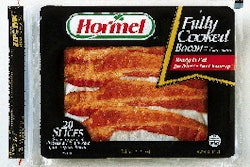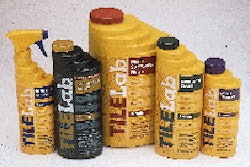
Success doesn't always breed success. Just ask Fomo Products, Inc., a Norton, OH-based maker of liquid polyurethane insulation products used by residential and commercial building companies. Until the early '90s, Fomo packed these chemicals only in disposable steel containers. It still offers these containers, but by 1992 the company introduced the products in refillable steel containers, purchasing 50 containers initially.
As sales of its Handi-Foam® grew, Fomo had to purchase a more substantial inventory of containers. That overtaxed the company's manual tracking system, causing Fomo to "lose" some containers. The company sought three round trips for each container but determined that while some met or exceeded that number, most fell short. On average, each container made 1.8 round trips.
By last year, Fomo Products righted the situation. It now maintains constant control of some 2ꯠ steel containers, each now averaging three round trips. Fomo credits its successful turnaround to a returnable container fleet management system developed and coordinated with Sherkin & Associates (Toronto, Ontario, Canada), a consulting firm that specializes in cost-effective solutions to industrial problems. Greater control over its steel containers has also allowed Fomo to:
* Reduce the average number of days to fill an order from five to one,
* Decrease "short-shipping" by 75%,
* Comply with hazardous materials shipping regulations in eight months, and
* Respond better to customer needs.
The advantages delivered by using returnable containers have helped Fomo reduce costs while increasing sales. Fomo general manager Stefan Gantenbein tells Packaging World that this combination of factors, plus not having to buy more new containers, yields annual total annual savings of $40ꯠ to $60ꯠ.
Realizing limitations
Fomo sells 17- and 27-gal quantities of Handi-Foam in a 27-gal container, 60- and 100-gal offerings in a 100-gal container, and a 250-gal size in a container that resembles a large propane tank. Customers purchase containers in sets of two, with one container holding chemical A, the other chemical B. Tubes connected to both containers lead to a spray hose that a worker uses to spray the hazardous chemicals. The two chemicals mix at the point they're sprayed. As the user pulls the trigger, the chemicals are dispensed in a spray foam that expands and adheres to virtually any material, curing in about 30 sec. The chemicals provide thermal insulation for houses, airports, schools and various buildings--even in refrigerated trucks. The tanks or containers that hold the chemicals are supplied by Worthington Cylinders (Columbus, OH).
"We've been in business since 1975, selling disposable containers of our product," explains Gantenbein. "In 1992, we introduced a line of refillable steel containers. We started off with 50 containers, then went to 100. Every time a tank or container went out, we logged it out. When a container came in, we logged it in. We kept manual log sheets because we felt we could handle these smaller quantities," he recalls. "Based on our own monitoring, we determined we were getting an average of less than two return trips per container."
Gantenbein notes, "About two years into the program we discovered we no longer had full control of our tanks. We finally realized that when we would ship a tank to one company, and it was returned by a different customer." That situation occurred in some cases when Fomo shipped to a distributor who in turn sold the container to one of its customers, who then returned the empty container to Fomo. Fomo didn't know the distributor's customer. That process has now changed. When a distributor receives an order, it conveys that information along to Fomo so that it knows who the end user is and can follow up with that user when the container is ready to be returned.
But previously, some "lost" tanks were literally "written off" by Fomo as missing in the field. This was costly for Fomo. Gantenbein says the tanks "are our assets, with each container costing about $500."
Aware of the poor container return averages of the costly containers, he says, "we did some brainstorming and began working with Sherkin. We identified different reasons why we weren't getting containers back, and we developed a program to eliminate those problems and regain control."
Tracking the system
Regaining control of the reusable containers began with the use of software designed by Sherkin & Associates. With this software, Fomo personnel began recording incoming containers. The next step was for Fomo to update its database. Rick Dansizen, the company's two-component refill supervisor, says Fomo discovered three primary conditions that were causing tracking problems.
One involved "orphaned" tanks/ containers that had no corresponding serial number in the system. When a tank came back without a serial number, the software "flagged" it as unrecognizable. The tank was then given a new serial number to help track its future movement.
The second difficulty was with tanks that had duplicate numbers. The software helped identify when a returning tank's number matched that of another still out in the field.
"Phantom" tanks represented the third problem. This category was defined as where Fomo had a serial number but could not locate a tank with that number. Fomo sent letters to customers believed to have these tanks because untracked, uncertified tanks could pose potentially expensive regulatory risks. That step significantly reduced the amount of phantom tanks. By mid-'97, Fomo Products regained control of its returnable fleet.
How it works
Dansizen explains that when an order comes in, a customer service representative enters it into the software on a computer. Order number, customer name and location, item number, requested shipping date information and any special concerns are entered into the database. Fomo says about 62% of its shipments are in the U.S., with the remainder exported to Canadian customers.
That information is available to several key Fomo representatives, including those responsible for filling the order. Personnel read the order and determine if the necessary tanks are in stock. "We never used to maintain an inventory," says Dansizen. "But now we do. We assign an order number in the computer, pull the tanks we need from stock and it's out the door, normally in about a day."
That wasn't always possible in the past. "Because we can track the containers better now, we're able to get them back quicker," he says. That means Fomo can fill orders more quickly than the five-day period it once took to ship them. "I can't remember short-shipping any orders where we're not able to fulfill a complete order," says Dansizen.
The actual filling of the containers is done on a system developed many years ago by Fomo Products. The company manufactures the proprietary blends of chemicals, which are stored in huge tanks. The liquid is pumped into the individual container through a valve. Fomo connects valves and other plumbing to the containers.
The containers are filled on a scale to the appropriate fill weight. For example, a 100-gal tank holds about 830 lb of chemicals, depending on the density of the specific chemical blend. Smaller containers are placed onto pallets and moved into a shipping area where common carrier trucks are used to ship the products to the customer or job site.
Quantifiable gains
Shipping orders faster and greatly reducing short shipments are two key benefits Fomo attributes to its tracking system. Another critical advantage is achieving Department of Transportation compliance.
"Each container has to be certified every five years with independent testing to pressurize them and make sure the valving and plumbing hold the 200- or 250-pounds-per-square-inch pressure that's necessary," explains Gantenbein.
Certification dates and the status of each tank is necessary for Fomo to meet D.O.T. regulations. Not being able to track tanks jeopardized that status. Gantenbein says violations can be as high as $25ꯠ per tank. "And with 2ꯠ tanks out there, you can imagine the potential financial liability we have," he notes.
"With our past paper trail system," adds Dansizen, "it was easy to lose a sheet of paper, but now the computer tracks it all. The minute a tank is returned we log it back in. We check tank weights, we know their history and we can note any container damage on a customer-by-customer basis."
Improved tracking yielded some surprising benefits for Fomo Products. "Not too long ago we had a situation where a customer didn't feel they should pay for an order," Dansizen relates. "They were talking courts and so on.
"The information from the computer gave us the proper documentation on the order, lot numbers, dates and all the information we needed in our system." That helped eliminate a specific problem.
With the tracking system, Fomo Products has improved its control of the containers throughout their cycle. Dansizen says that in general, Fomo tries to recover each container in 120 days.
"We've developed a 'stopwatch' system where the software informs us when a customer has had the tank for 30 or 60 days. At that time, we have a representative call the customer to determine how things are going and answer any questions. That's improved our customer service," Dansizen says. As the 120-day mark approaches, another call is made to that customer to facilitate the container's return. The process helps keep containers moving back and forth between Fomo Products and its customers, thereby building sales.
Fomo tapes a prepaid bill of lading to each container so that once the customer is done with the tank, it calls a carrier. The carrier returns the tank to Fomo Products. Fomo pays for freight, though Dansizen confirms the cost is built into the product's sales price. While he didn't know the exact costs customers pay for the filled tanks, he estimates that a set of two 100-gal tanks runs upwards of $3ꯠ.
Once containers are received, they're brought to Fomo Products' in-house lab for quality control tests. Pressure checks are taken, and any remaining chemical is pumped through hoses into a separate 17-gal holding tank. The empty tank from the customer goes through a thorough cleaning process, including power washing, and is then painted. New plumbing (hoses and valves) are attached, and the tank is pressure-tested before it's refilled and ready for another customer shipment.
Once the separate 17-gal holding tank is filled, it is tested like a new container to make sure it meets quality specifications. If so, it can be sold. If it falls into the company's Non-conforming unit return (NCUR) status, a disposal service company is contacted to take the container. That same fate awaits any other containers that fail Fomo's lab testing.
"What we've saved so far with this system has far exceeded our investment," says Gantenbein. "We look at factors like operational savings, fixed assets, interest and appreciation factors and disposal of chemicals." Dansizen tells PW that Fomo Products anticipates that eventually there will be additional charges for disposal of these containers in the U.S., as he says there are now in Europe. "That will drive up our costs, and so using refillable containers is the best way."
Gantenbein concludes, "On an annual basis, we probably save $40ꯠ to $60ꯠ a year using the refillable containers. Those are considerable savings and that's why you invest in something like this."






















